
| Go to
web site main page, learning resources index. |
Content Created: 2017-05-17. File last modified: |
Human beings have known how to write for slightly over 5000 years. Probably longer. So influential has writing become for us today that people sometimes even confuse writing with language. If I ask someone how many vowels there are in English, I am likely to be told that there are five (a, e, i, o, and u —some people add y as an afterthought). That is the number of vowel symbols used to write English. The number of vowels used to speak English is considerably more. Indeed, linguists count about fifteen for most standard English dialects.
People say five because it seems so natural to think about the written form of language, rather than speech. Similarly, writing down our thoughts is so convenient that universal literacy is considered an obvious goal for any modern society. A nameless UCSD professor once told me in all seriousness that human thought was not possible without writing, and even advocates for return to a “paleo-diet” do not advocate a return to universal illiteracy.
In fact, of course, writing is a recent invention. It did not exist through most of human history. Furthermore, the role of writing has varied from society to society —when it has had any role at all— and illiteracy is not uncommon in the world today.
Who is literate, how literate, and literate in what sort of writing system has always varied. Also variable have been decisions and preferences about what should be written down and why, and about who should be allowed, encouraged, or forbidden to read what. And there is no reason to believe that writing originated the same way in all parts of the world where it is known. We start with origins.
Keeping Books. One hypothesis about the origin of both writing and numerical notation links it to small clay tokens used by ancient Sumerian traders in what is today Iraq. These tokens were shaped to resemble commodities (like sheep), and could be encased in a ball-shaped clay “envelope” to make a shipping invoice. The envelope was baked in the sun after inclusion of the tokens, so they could not be examined without breaking the envelope. If a merchant’s client received a ceramic clay ball containing eight small clay sheep, it showed that he should have received eight sheep with it. An impression of the sender’s unique seal ensured that the envelope and its contents were genuine.

Eventually, rather than the tokens themselves, traders took to using drawings of the tokens, inscribed on a piece of clay, still encased in the clay envelope. For convenience (to avoid sending the wrong envelope, perhaps), a duplicate inscription was often made on the outside of the envelope. The drawings used in imitation of the tokens, it is now believed, constituted what evolved sometime before 3000 BC into the Sumerian writing system, and the pictures of the individual tokens constitute the earliest cuneiform signs. (In some circumstances it is useful to distinguish signs from symbols, but for present purposes, as in most discussions of writing, the two terms are used interchangeably, together with “graph.” The term “letter” normally refers only to a symbol that is part of an alphabet; “character” to a symbol in the Chinese writing system; and “glyph” to a symbol that is part of the ancient Egyptian writing system or systems that are similarly pictorial.)
The word “cuneiform” literally means “wedge-shaped” (from Latin cuneus, “wedge”) and refers to the effects of trying to draw tiny pictures by scratching and stabbing a piece of clay with a reed —the inevitable result is little wedges. The transformation from mere pictures to true writing occurred when the little signs progressed from hasty pictures representing specific objects —like a crude picture for “sheep”— to symbols standing for the sounds of the words they represented —like three signs for sh-ee-p. This was the critical change in the conceptual system underlying writing, and we need to see clearly how it worked. (The potentially separate evolution of numerical notation seems in fact to have been closely linked with this.)
Going beyond sheep to the general process, we start with a made-up example with pictures of hearts, umbrellas and pencils:
*-Some scholars call a written symbol a logograph when it stands for a particular word in a particular language —Greek logos (λογος) means “word”— but they call it an ideograph, if it stands for an idea, rather than a particular word. If ✏ means “pencil” it is a logograph. If ✏ refers more broadly to any sort of writing device, pencil or not, or perhaps also to the act of writing, then it is an ideograph. The distinction is rarely useful, and the term “ideograph” is generally used without such a distinction. We will not observe the distinction in this essay.
Ideographs. In a system in which ♥ means “heart,” ☂ means “umbrella,” and ✏ means “pencil,” the symbols stand for whole words or ideas. They are usually called “ideographs” or “ideograms,” since they represent ideas but not particular sounds.*
Sometimes the same written symbol is used across languages so that it stands for different spoken words. For example the symbol “$” stands for “dollar” in English, but it is also used for peso in Mexico and quetzal in Brazil; “₤” stands for “pound” in Britain but for “lira” in Turkey. Similarly, symbols like “5,” “±,” and “&” stand for ideas, corresponding with different spoken words in different languages. In the bumper-sticker “I ♥ San Francisco,” the symbol ♥ is read “love,” but in “Yo ♥ Sevilla” it is read “amo.” The ♥ is an ideograph. (I have even seen “我 ♥ 上海,” Wŏ ài Shànghǎi, where ♥ stands for 爱.)

An ideograph may stand for a family of related concepts (not necessarily words) in a language. For example, ☂ could mean “umbrella” as a label on an umbrella stand, but it might mean “rain probable” in a weather report. Confusion is possible. If context cannot tell us which meaning is intended, then another ideogram is needed. For example, if ☂ means “umbrella” then perhaps some raindrops could be added ☔ to make sure that the symbol instead means “rain probable.” (But if the meaning is clear without the raindrops, then why bother having two symbols just because there are two spoken forms?)

Homonyms. Sometimes two unrelated spoken words are homonyms, that is, they have the same sound. “Duck” can refer to a bird, but it is also a verb meaning to lower one’s head to avoid an obstacle, such as a low doorway. In theory, I could post a picture of a duck —or even a rubber duckie— over the door to call attention to the problem, and a visitor would know that the noun (a duck) is being used to represent the verb (duck!). The sign is a picture of a bird, but it symbolizes not the bird, but rather the sound used to name it, which then has to be understood as a verb. Of course, the sign would make sense only to an English speaker.
Similarly we might use ♥ not as a symbol of loving but as the sound of the word “heart,” which could also be a male deer (a hart) or half of the word “heartburn,” or for some speakers the first syllable of the word “artist.”
In fact, we might make up a whole table of all the possible syllables in English and assign to each of them an arbitrary picture. We could then write English, using one picture from our table for each syllable. Most pictures would be inappropriate as pictures for the ideas expressed, but that wouldn’t matter. We wouldn’t be using them as pictures, but merely as symbols for the spoken syllables, like the “4” in the greedy license plate “MOR4ME.” A writing system made up of symbols representing spoken syllables is called a syllabary (SILL-a-berry).
Unfortunately, English has a very large inventory of phonologically allowable syllables, so our table would have to be enormous. Some languages, famously including Japanese, exhibit a very small inventory of possible syllables (although often very long words). This is because in Japanese, no syllable can end in any consonant other than -n, and no consonant can occur before that -n. Similarly there is a very small inventory of sounds that can occur at the beginning of a syllable. Accordingly, Japanese can be written quite efficiently with a syllabary. In fact that is how it is written, although with a very heavy admixture of Chinese characters, and a full table of the Japanese syllabary comes to only 51 symbols (some of which have even come to be pronounced identically).
Ancient Iraq Revisited. What actually happened in Mesopotamia, then, is that the system of Sumerian symbols for numbers and inventories of products eventually came to be read for their sound value some of the time but for their value as pictures at other times, producing a system made up partly of ideographs and partly of syllable signs. Where there was confusion, ideographs and supplementary sound signs might be combined to clarify the intended spoken word. Thus we might differentiate ☂u for “umbrella” and ☂r for “rain possible” and ☂s for “sunshine” and ☂w for “wind.” This is not graceful, although it works. Once the written forms are made different, the script links the written language to the spoken language. Once Sumerian symbols accomplished this refinement, what you could say, you could also write.
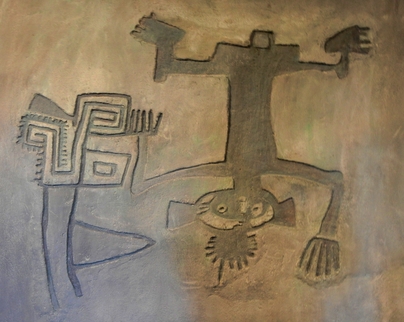
The Definition of Writing. Connecting written notation directly to spoken language, was not an obvious thing to do at the beginning, but it turned out to be a transformative innovation. Being able to write anything you can say is the mark of a true writing system. Any system which falls short of that goal is not really writing. The system of international road signs, for example, is not a writing system because you cannot write a grocery list with it; you cannot write love poetry with it; and you cannot answer college exams with it. If a notational system is not able to record grocery lists, love poems, and the answers to college exams, it is, for present purposes, not a writing system. By this definition, the world has many kinds of written notation, only some of which are actually writing systems. Can you read wiring diagrams? Musical notation? Chess game histories? Genealogies? C++ programs? These involve written notational conventions, but they are not, in themselves, writing systems.
The Spread of Sumerian Writing. Ancient Sumer was located in the far south of what is today Iraq. Sumerian does not seem to be related to other known languages. Very early, Sumerians were in close interaction with people just to the north of them, the Akkadians, whose language belonged to the large family of “Semitic” languages spoken ever after in Iraq and adjacent regions. (The most important Semitic languages in the modern world are Hebrew and Arabic.) Scholars assume that there was a fair amount of Akkadian-Sumerian bilingualism, and Akkadians initially wrote in Sumerian, gradually trying to adapt it for use in Akkadian. Akkadians and other Semitic-speakers became the politically dominant populations after the end of the Sumerian period (about 2300 BC or so). Each of these peoples made changes (not always consistently) to accommodate the fact that Semitic spoken languages were differently structured from Sumerian.
In general these changes tended to reduce the number of ideographs and to increase the total proportion of any text represented by syllable signs. In addition, many of the syllable signs were used to stand for parts of syllables, typically individual consonants. Semitic languages have the distinctive property that many words are built on roots made up entirely of consonants, with the vowels being used to express tense, plurality, or other changes. The result was somewhat as though we took our symbol for “heart” ♥ and used it only for its first consonant, “h,” took our symbol for “pencil” ✏ and used it only for its last consonant, “l,” left out any vowels, and spelled “hill” by writing ♥✏, standing for hl, the sound of the consonants in “hill.” (That may not seem better than a picture of a hill, but it is. Stay with me.)
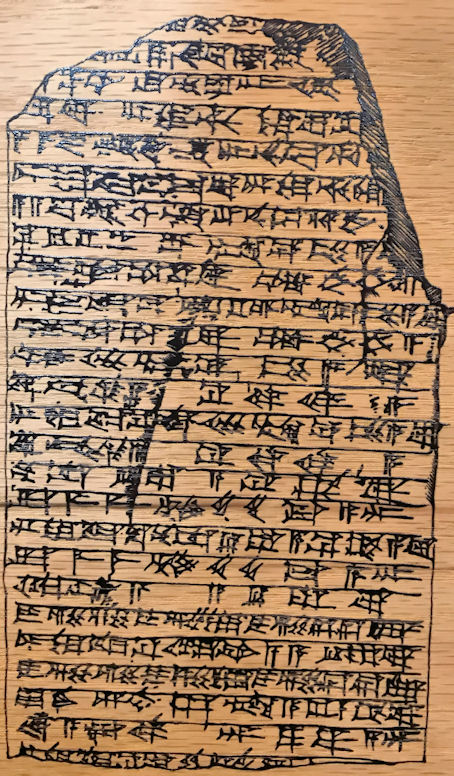
Virtually from the beginning, moreover, the Sumerian pictures had not really looked much like pictures. For one thing, it is hard to draw pictures so they come out the same way all the time. — ✏ easily comes out ✎ or even ✐ instead of a proper ✏. Secondly, from the standpoint of an efficient writing system, it doesn’t really matter what a sign looks like, but only that it contrast with the other signs in use. That is to say, pictorial niceties don’t actually make much difference; contrast does. But most importantly, Mesopotamians wrote on clay, using a reed to make fine impressions, which tended to optimize small wedge-shaped strokes. These didn’t have much potential for looking like pictures even in the best of hands. They looked like the text shown at the right (a hymn to the Mesopotamian goddess Ninkasi, from an exhibit at the San Diego Museum of Man).
Later peoples used their cuneiform and cuneiform-derived scripts on all sorts of surfaces, and with each change of surface or writing implement, the appearance of the cuneiform signs changed somewhat. Just as drawing pictures in wet clay is nearly impossible using a reed stylus, so drawing wedges using a quill or a brush on parchment or papyrus is clumsy at best. So shapes evolved. Hebrew, for example, eventually stabilized in a form that looks quite far removed from the cuneiform that we know to have been its ancestor:

(The dots and bars under the Hebrew letters represent vowels and are a comparatively late refinement of ancient Hebrew script. They are normally omitted in modern Hebrew.)
Furthermore, the process of reduction in the number of signs continued, so that the syllabic symbols disappeared altogether, leaving an alphabet of consonants.
The evolution from syllabary to alphabet in southwestern Asia seems to have happened first among the Phoenicians about 1000 BC. The Phoenicians were a trading people operating out of what is today Lebanon, whose script is ancestral to nearly all modern European and Near Eastern alphabets ranging from Greek and Latin to Hebrew and Arabic. As it moved westward, this ever-changing script diffused beyond the world of Semitic languages to languages where vowel sounds had a role more like their role in English. In these cases some of the signs were pressed into service to represent the vowel sounds. This appears in the archaeological record with Greek as written in the script that emerged about the time of Homer (ca 800 BC). That Greek script is what gave birth to all (or apparently all) European alphabets. (We do not actually know the origins of the Scandinavian “runic” symbols.)
English uses the Latin (also called Roman) alphabet, although with a couple of extra letters —J and W— that were unknown to the Romans. In most modern European languages (and many European-influenced ones such as Vietnamese and Swahili) some variant of the Latin alphabet is used. The Latin alphabet fits some spoken languages better than others. (English provides a conspicuous example of a fairly serious misfit.) Frequently extra letters are used —not just W and J but such letters as the ß of German or the ı of Turkish. Most “extra letters” are created by adding diacritics to existing letters. Examples are the å of Swedish, the ñ of Spanish, the đ of Icelandic, the ł of Polish, the ţ of Romanian, the ű (in contrast to ü) in Hungarian, the ř and š of Czech, the ğ of Turkish, or the ĝ and ĵ of Esperanto.
Who Was First? We know a good deal about how writing diffused from Sumerians to the speakers of other languages, including languages where some tinkering was necessary to make it work. This diffusion is well documented because we have the succession of texts and can see the influences and the gradual changes. But Sumerian may not have been the first writing, nor the Phoenicians the first to create an alphabet, and archaeologists continue to stumble across evidence that may (or may not) be earlier writing.
For example, in 2007 Chinese scholars announced that about 1,500 markings on a cliffside in northwestern China had been tentatively identified as possible written characters and dated to sometime before 6000 BC. A couple years before that, in 2005, archaeologists announced finding eleven symbols dating from about 6400 BC that may represent a yet earlier stage of the Chinese writing system. That long “gap” of over 4,000 years between the dates assigned to these new finds and our previous oldest candidates for Chinese writing at about 1200 BC, combined with the ambiguity of the designs, makes many experts very cautious about declaring this to be the world’s oldest known writing.
In a find announced in 1999, scholars working in central Egypt found earlier alphabetical writing than has ever before been known. It records an otherwise unknown Semitic language, was found slightly north of Luxor, and dates to between 1900 and 1800 BC. It is clearly writing; it may be the earliest alphabet in history; and it certainly is the earliest alphabet we know about. But it does not seem to have left descendants. What it does tell us is that the principle of the alphabet —a small number of signs that represent meaningfully different sounds of a spoken language in a way that could constitute a true writing system— was apparently discovered more than once in human history.
We have seen that the Sumerian writing system spread, evolving as it went, and diffused across several other language communities, although not everywhere. The adoption of an innovation requires motivation, and the advantages of writing were not necessarily obvious among all the peoples who were probably witness to it. Indeed, writing may have disadvantages as well as advantages, as we shall see below.
The general idea of writing (as opposed to any particular set of signs) can also diffuse, even when a particular system does not. When only the general idea of a practice spreads, without the details, the process is called stimulus diffusion. There have been several instances of stimulus diffusion in the transmission of writing systems.
Sequoyah. The best documented case of stimulus diffusion, the one that we find in textbook discussions of it, concerns a young Cherokee named Sequoyah. Sequoyah was born in the 1770s to a Cherokee mother and and a white father in the village of Tuskegee in what is today Tennessee.
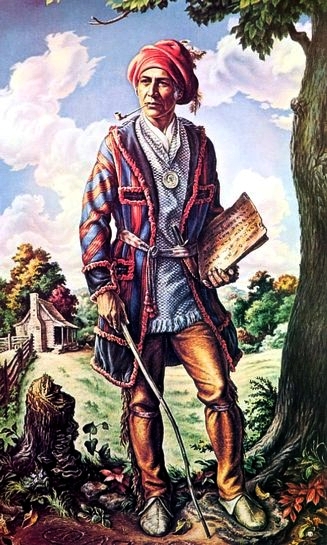
Brought up steeped in Cherokee tradition, Sequoyah became a skilled hunter, fur trader, and silver worker. He saw that the white people, whose relations with the Cherokee and other tribes had never been good, had an advantage because they could communicate by making marks on paper, allowing communication across time and space without direct contact.
Beginning in 1809 Sequoyah determined to create something like this for the Cherokee. With no knowledge of English or how English writing actually worked, and with no analytical grasp of the phonology of Cherokee, he nevertheless set out to try to assign the written symbols he saw used in English —some letters and some numbers, some modified or turned in various ways— to “sounds” of Cherokee speech. His efforts were mocked by those who knew of them, and apparently the project did not begin well, but by 1812 he was able to demonstrate a working syllabary that impressed tribal elders as useful, and it was adopted by them as the “official” orthography (writing system) of the Cherokee language. (Briefly, each symbol represented an initial consonant or consonant cluster plus one of Cherokee’s six vowel sounds. The symbols obviously, although inspired by English, are not used the same way. The symbol “K,” for example, represents the Cherokee syllable “tso.”)
Fifteen years later Sequoyah’s syllabary had been widely enough learned that money was allocated by the tribe to buy a printing press and commission syllabary type fonts. A newspaper in the new script —the first known Native American newspaper in the United States— finally appeared on February 21, 1828.
The famous Sequoia trees of California are named in his honor —the spelling is different because it has been filtered through botanical Latin. The village of Tuskegee, where he was born, was apparently burned down in 1776 in an American-Cherokee battle. Today the site is at the bottom of Tellico Reservoir, but a “Sequoyah Birthplace Museum” stands nearby.
The story of Sequoyah is well documented and is a clear example of the idea of writing being seized upon by someone who understood the advantages writing could confer, but had to invent his own system. The term “stimulus diffusion” was inspired by this famous case, but it is a common kind of diffusion, and the idea is particularly useful in considering writing systems.
Prehistoric Stimulus Diffusion: Sumer & Egypt. Stimulus diffusion can be hard to identify. In the case of Mesopotamia and Egypt, it is difficult to be sure that borrowing of the idea of writing occurred at all. On the one hand our first written records in Mesopotamia and Egypt look quite different. Egyptian was written from the beginning on surfaces other than soft clay, so that there was no reason for it to be made up of wedges. But on the other hand they are so close in time (in both cases slightly before 3000 BC), that it is hard to imagine there was no connection. Is it reasonable to imagine that two peoples with little knowledge of each other should “just happen” to invent sophisticated writing systems simultaneously? If not, who was stimulated by whom? Who came first? How can we tell?
Partly because of the provocative token-to-cuneiform transformation, it has usually been assumed that Sumerian cuneiform preceded Egyptian hieroglyphics. But Pre-dynastic Egyptian glyphs have now been found dating to between 3300 and 3200 BC, that is, from approximately the same period in which writing was first emerging in Sumer. (The new glyphs are associated with the tomb of a king named Scorpion at Abydos. He is discussed briefly in the essay on Egypt found elsewhere in this Sourcebook.) The Egyptian text deals with the sale and transportation of jugs of wine, suggesting that there was nothing particularly unusual about its being written down. This early date for Egyptian writing makes it possible that the stimulus diffusion went the other way, with Egyptians independently inventing writing, and Sumerians then acting under Egyptian inspiration. (That, of course, leaves the famous tokens as a mystery.)
Meanwhile, in the valley of the Indus river in what is today Pakistan, another, very dissimilar script appeared among the Harappa people. Indus script, dating from about 2600 BC or so, remains undeciphered because all examples consist of extremely short inscriptions appearing in seals, so there is no running text to provide context, and there are no bilingual inscriptions (like Egypt’s famous Rosetta stone) to help scholars get a start on it. (Here’s your chance for fame and glory.) We do not even know whether it constituted a full writing system. At the end of the XXth century archaeologists discovered some similar-looking glyphs dating from a much earlier phase —the so-called the Ravi Phase— of the Harappa culture. The Ravi Phase dates from 3300 to 2800 BC. Provocatively, that makes Indus Valley script more or less simultaneous with the emergence of writing in Egypt and Sumer. The possibility therefore exists that writing could have spread by stimulus diffusion from any of these three areas —Sumer, Egypt, or the Indus Valley.
More Stimulus Diffusion. Diffusion of the basic idea of writing, independent of specific scripts, happened again and again. Egyptian writing itself gradually diffused southward to generate quite a different hieroglyphic system at Meroë in Nubia (modern Sudan), another case of stimulus diffusion. The Meroë glyphs look vaguely Egyptian, but represent a different language and do not have anything like their Egyptian meanings or sound values.
Similarly, so-called Linear-A script in some parts of what is today Greece was probably inspired by the idea of writing, but appears not to have worked like other known scripts, certainly not like later Greek (Linear-B) or still later, Classical Greek writing. (Like the Indus script, Linear-A remains undeciphered, and since there are very few Linear-A inscriptions, that situation is unlikely to change.)
Apparently independently, scripts arose in other areas as well, most conspicuously China. China, by chance, was the home of a family of languages characterized, like Japanese, by relatively few allowable syllable types. Such languages lend themselves to being represented by syllabaries. Syllabic writing would have seemed even more “natural” than in Mesopotamia. However, in China each syllable was also independently meaningful, and even multi-syllabic words, were not long. Therefore a simple syllabary would not distinguish separate “words” that happened to be pronounced the same way. We shall see below what some of the effects of that were.
The Chinese writing system was in turn an inspiration to the creation of other systems in the lands around it, spawning the Japanese syllabary from reduction and simplification of some Chinese characters, and inspiring other scripts (like the modern Korean alphabet-syllabary combination script) based on heavily modified Chinese characters.
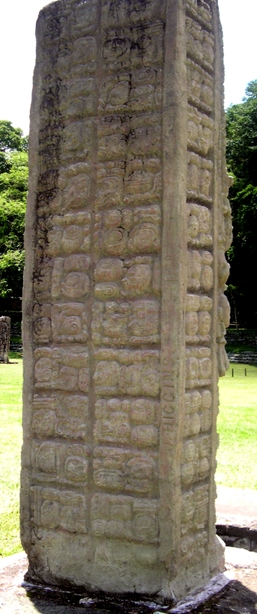
Not all writing systems are equally efficient for all purposes. The matter need not detain us for long, but it is important to remember that considerations of efficiency may affect how writing is learned or used (or whether it is learned or used at all). This has been true throughout history and to a degree it remains true today. Here are two examples.
Example 1: Maya. Maya script was one of the most profoundly inefficient creations in the history of human thinking. It definitely was a writing system in the technical sense that it could be used to write grocery lists, love letters, and university exams. And it was beautiful. But it was also an inefficient mess of alternative forms —scribes deliberately avoided representing the same symbol the same way twice— making the system slow to write, hard to read, and long to learn. That is one reason why it took so long to decipher. (It turned out to work almost exactly like Egyptian and Chinese, which we will examine below, but the early decipherers didn’t appreciate the generic process.)
Example 2: Chinese. It takes a lot longer for a Chinese child to learn to read Chinese than for a Latin American child to learn to read Spanish. Written Chinese involves thousands of symbols (even though most are compound ones, as we shall see) and stylistically it limps along after the spoken language. In contrast, Spanish involves a handful of symbols and usually tracks spoken language well. So people reasonably enough say that the Spanish writing system is more efficient than the Chinese one, by which they mean it is easier to learn.

However, once the Chinese system has been mastered, it appears (to me) to be possible that (1) most Chinese can speed-read more efficiently than most Spanish speakers can, and that (2) this difference is a function of the script itself, not necessarily of the way reading is taught. If that turns out to be true, then the extra time spent mastering the Chinese writing system may be regained over a person's lifetime in increased reading speed. That would make Chinese characters a more efficient writing system than Spanish if efficiency is measured in reading speed. That might also be true if, say, one orthography tended to produce better memory of the text read than did the other one.
Yet other probable variations in efficiency involve the effort or speed of computer text input by human operators, the memory space required to store text, the accuracy of optical character recognition, the legibility of text at different distances, the total display space need for a text of given length (such as how many pages it takes to print such and such a document), and so on. These kinds of efficiency hypotheses have not been subjected to the necessary but difficult experimental tests, so nobody actually knows. (Doing such research could be your chance for fame and fortune.)
Some scripts involve greater legibility than others. For example, when the so-called “Shavian” script was proposed as a replacement for Roman letters in English, one of the selling points was that Shavian letters could be read from a greater distance and copied faster and with lower error rates than Roman letters. To my knowledge, little research has actually studied the extent to which errors are made because of similarities in letters in one script as opposed to another. (Within a single tradition users are often aware of such issues. An English lower-case “a” can look almost identical to a lower-case “o” in some type fonts, and lower-case “m,” “n,” “u,” and “r” can seem almost identical in handwriting. Attention has always been given to the problem in Hebrew, where the similarity between the letters “ב” (bet) and “כ” (kaf) has caused scribes to fret ever since the script emerged in antiquity.)
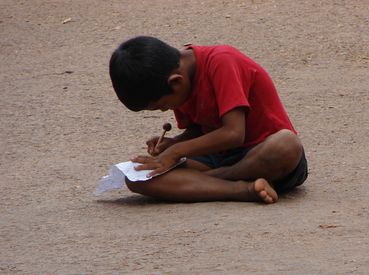
“History” is sometimes defined as beginning when writing does. Life before writing was “prehistoric”; societies without writing are “primitive” or, more politely, “non-literate.” And so on. But as we noted at the beginning, most humans through most of the human career have been illiterate. And there are few societies on earth, even today, in which all people are usefully literate, and not all writing systems are equally accessible.
The common expression “literate society” is therefore inherently misleading. The role of writing systems in societies varies dramatically. Especially in historical perspective, almost no society is “literate” in the same sense that any other society is.
Writing can vary in quantity. Some writers call an early society “literate” if somebody somewhere scratched a glyph on a stone, even if it remains undeciphered. Obviously that is a different literacy from what one sees in, say, modern Finland, where pretty much everybody can read and write with ease. There is, in other words, a continuous gradation between the literacy of a tiny group within a society and near universal literacy, and that gradation is not captured by simply saying that a society is “literate.”
Writing can vary in function. Using writing only for carving a few stones to mark a tomb or to glorify a king or only for covering a parchment with a table of eclipses, or only for scribbling magic spells or only for noting commercial transactions is simply not the same as using writing to create novels and legal codes and newspapers and Email.
Writing can vary in mastery. And finally there are gradations in the extent to which “literate people” in fact master a writing system or bother to use it even if they can. After all, if you don’t actually read, it doesn’t make much difference whether or not you can read, just as your English teachers have always said.
These considerations interact: If writing is awkward, why bother? If all that is around to read is tombstones, why would one care?
Acknowledging the above caveats, the appearance of texts in human history really does mark a serious turning point. For one thing, as Sequoyah observed, texts speak across time and space to people who are absent when and/or where the texts are created. And for another thing writing can store knowledge that may not be in anyone’s head. Hence texts have permited (and encouraged) a number of important cultural phenomena. It is not hard to make a list. Here is mine, with some examples. Feel free to work up your own.
1. History, including: (A) chronologies, such as Confucius’ history of his home state of Lǔ, (B) spin doctoring, such as Caesar’s report to the Roman Senate to say that conquering Gaul made excellent sense and that he was brilliant in doing it, even though it was technically illegal, (C) genealogies, such as the line of descent of a royal house explaining why the ruler is entitled to rule, (D) news, such as the fact that we are at war or the king has died or that we have had a lot of rain this year.
2. Accounts of other places, such as Marco Polo’s popular account of his trip to China or a tour guide of Vancouver.
3. Knowledge accumulation (data storage) beyond what one person can remember, including: (A) short-term notation while performing calculations, (B) efficient bookkeeping, catalogs, and inventories, (C) tables of eclipses or other calendrical or sidereal information, sometimes of religious relevance, (D) big data, (E) census for purposes of collecting taxes or drafting armies. (Career bureaucrats in traditional China sometimes hid the census records for a district from a newly appointed magistrate to make him dependent upon them to collect taxes for him.)
4. Instruction, including: (A) elementary textbooks, (B) religious scriptures and moral tracts, (C) complex instructions (such as recipes, medical prescriptions, or machine assembly instructions)
5. Contracts, especially any agreement without which some people otherwise could find it in their interest to have different memories later, including: (A) labor, trade, or marriage agreements, (B) wills, loans, gifts, (C) oaths of loyalty (including loyalty to criminal gangs).
6. Art, including all aspects of writing, from poetry to novels to calligraphy. (In general, anything that is within our conscious control can be done with or without the grace, skill, originality, appropriateness, and other qualities that constitute art, so writing as art is not surprising. Even making gross noises with your armpits can be done with greater or less artfulness. If in doubt, ask your suitemates to demonstrate.)
7. Data leaks. (You can never be sure who will read a text. Just as Caesar didn’t compose the Gallic War for us, but we read it anyhow; you probably don’t intend your Facebook page for the contemplation of a potential employer, although potential employers routinely look at them. And, like Caesar, you certainly don’t expect it to be read two thousand years from now.)
Losers. Not everybody loves texts. “A big book is a great evil” (Μέγα βιβλίον μέγα κακόν), wrote the philosopher Callimachus (Καλλίμαχος) of Libya (310-240 BC), and it became his most famous aphorism, especially among students. Callimachus aside, many of the advantages of writing in the list above have consequences that disadvantage someone.
And so on. On the whole, not being able to fudge earlier events and intentions would seem to be a good thing, even if that is not always the case, and obviously there are losers as well as winners. (Click here for more detailed downside examples.)
Perhaps one of the biggest “issues” with literacy is its role in defining elites, to which we briefly turn now.
In some societies the use of literacy is a key means of social differentiation, with the elevation of people who can and do use writing (often wealthy men) over illiterates (typically women, children, the poor, the uninitiated, &c., depending upon the period and place). Especially when literacy is not easily mastered, only some people have the talent, leisure, or ambition to bother with it. Looking cross-culturally, we see several patterns:
Craft literacy. The term “craft literacy” has been coined to describe the literacy of a society in which the ability to use written language is a “craft,” limited in distribution to specialists. These may be a priesthood (as in Egypt) or a closed occupational category of scribes (as in Mesopotamia). Often —not always— there are deliberate attempts to keep literacy exotic, sometimes defended by its connection with a magical or religious use of writing, but inevitably connected with a political or economic monopoly by the literate. In Egypt, for example, writing was a priestly monopoly, or at least the priesthood tried to keep it that way. (Even today certain documents may demand the specialized knowledge of professionals, such as programmers, publicists, or lawyers.) In Mesopotamia or in Classical Greek and Rome, in contrast, being a professional scribe was simply a job, and sometimes scribes were even slaves.

Elite Literacy. The term “craft literacy” goes somewhat past its range of convenience if it is generalized to cases in which literacy is generally extended to all upper-class males, as in classical India, Israel, Rome, or China, since the ability to use writing does not then constitute a craft as such. However, the issue of whom literacy includes or excludes obviously remains relevant. Sometimes the intricacies either of the writing system itself or, more often, of written style and stylistic flourishes become enormously complex, so that it can take years to master the art of writing “properly.” In that context, literary skill becomes a badge of elite status, and elites may even seek to deny the necessary education to “inappropriate” learners (such as women or slaves or farmers).
Leakiness. Unless the script is so clumsy as to be virtually useless for ordinary purposes (as Maya script was), knowledge of writing, or anyway the idea of writing, tends to leak out to the more general society, usually with some degree of simplification.
One of the most famous and compelling examples of simplified script leaking out for use among those denied “standard” literacy is the Japanese literary masterpiece, Tale of Genji (Genji Monogatari 源氏物語), written entirely in syllabary. The author, known by the pseudonym of Murasaki Shikibu (紫式部), “Lady Murasaki,” (ca 978-1031) was a court lady, but she wrote exclusively in the low-prestige hiragana syllabary because Japanese women were not supposed to learn standard, higher prestige Sino-Japanese script, the one full of borrowed Chinese characters. (The Japanese title should probably really be printed in syllabary form —げんじものがたり— not the Chinese-character form 源氏物語.) It is an irony lost on no one that the most famous work of Japanese literature was not composed using its most prestigious writing variant because the writer was female.
But usually the greatest variation across social classes is written style. In general, one can glimpse a tendency for evolution in two directions. One is toward high style, dependent upon broad education and reading and full of elegant flourishes, uncommon vocabulary, and allusions to prior literature. High style is used and enjoyed by elites for various reasons, but its effect, conscious or not, is to tag their own social superiority. The second evolution is toward low style, a more vulgate simplification used for rough-and-tumble, low-prestige, everyday needs of the less educated, like posting (misspelled) signs, making (abbreviated) grocery lists, or sending (slightly garbled) text messages.
In a few cases political revolutions have resulted in attacks on inaccessibly refined “high” styles as a way of breaking the upper-class stranghold on literacy. The most famous cases are Turkey (after the 1918 revolution), which sought to purge the language of Arabic and Persian loan words in favor of a purely Turkish vocabulary and syntax, and China (after the 1911 revolution) which sought to make written syntax follow spoken language. (A later, less radical reform in China simplified and sometimes consolidated the written characters in hopes of facilitating learning.)
In other cases, such as occasional spelling reforms in Europe, small adjustments have been made in the interest of consistency, or of recognizing overwhelming popular usage (adjustments that the French Academy refers to as tolerances). English, despite occasional unsuccessful private efforts, seems particularly ripe for fairly drastic reform, as (the students of) any college writing instructor can attest. (Like, dude, U otto be able to rite like U talk. Click here for a crotchety rant.)
Despite facile generalizations and widespread misunderstandings about language and writing, it is broadly true that the invention of writing forever changed human life.
Meaning, Sound, and Symbol. We end with a closer examination of how two non-alphabetical writing systems actually work: Classical Middle Egyptian and Literary Chinese. The goal is to provide more extended and memorable examples of the kinds of processes only briefly mentioned above. Both of these scripts are popularly misunderstood to be “picture languages.” They do involve pictures. However the point to note is that both are linked ultimately to the sounds of the spoken language, and therefore both are able to function as full writing systems, in which it is possible to write grocery lists, love letters, or college exams.
The examples here will show you how these writing systems function. Despite their superficial differences from each other, and despite the profound differences in the spoken languages that they are used to represent, the principles driving the writing systems are surprisingly similar. In each case the “picture” element —called a “determinative” for Egyptian or a “radical” for Chinese— is combined most of the time with a “sound” element so that the two disambiguate (clarify) each other, and can reflect spoken language clearly enough to function as full writing systems.
In Egyptian the set of phonetic elements makes up an alphabet, plus a few additional multi-sound signs. In Chinese the set of phonetic elements makes up an extended and desperately inefficient syllabary. Both systems are difficult to learn, but in both cases, the abundance and pictorialism of the written forms came to have calligraphic possibilities that made each of them somewhat more than merely a writing system.
1. Egyptologists have long used several special letters when representing the sounds of Egyptian. The following more convenient equivalencies are used here to replace them: ꜣ=a, ı͗=i, ꜥ=o, ḥ=hh, ḫ=x, ẖ=xx, ś=s, š=sh, ḳ=q, ṯ=ch, ḏ=j.
2. In this essay all Egyptian signs are given in left-to-right order. In ancient texts they could go in either direction —the glyphs with faces all looked toward the beginning of the text— in rows or columns. Glyphs were spatially blocked to make pleasing clusters when they happened to fall together, so one wrote a combination like 𓆓 𓏏 𓋰 in a single stack, read from the top down, never spread in a row, as here. Most computers don't understand this … yet.
Egyptian had an alphabet of consonantal signs, some of which apparently represented back-of-the-throat, vaguely belch-like hard breathing noises that don't exist in English. In order to make Romanized spelling line up with Egyptian ones, some transcriptions, including the one here, use vowel signs, but these letters actually stand for consonants or, in some cases, for glyphs that Egyptians wrote but did not pronounce —they were merely place-holders to which different vowels might be added. (Since nobody speaks ancient Egyptian any more, it doesn’t matter how you pronounce it. Suit yourself.)
Egyptian writing also used shortcut signs that represented more than one consonant together, (called “biliteral” and “triliteral” signs) and signs that represented meanings directly (called “determinatives”), although these last could not usually be used alone. To write in less space or more quickly, one used a biliteral or triliteral sign; to lengthen the text, one wrote the individual alphabetic signs, or used both the alphabetic signs and the bi- or triliteral signs! A conventionalized determinative usually followed, carrying a more or less direct picture of the meaning involved. Thus, although vowels were not shown, the redundancies made the connection to the spoken form unambiguous to ancient speakers.
Unfortunately, some biliteral or triliteral signs could represent more than one set of consonants, and therefore often increased confusion rather than clarifying things. For example, the triliteral sign 𓌂 could be used as a shorthand sign for three quite different combinations of consonants:
In such cases, one or more redundant letters of the “original” spelling, or even a determinative (or both!) nearly always had to be added to the triliteral sign, since otherwise the reader might not know which value of 𓌂 was intended.
Since vowels were not written, spoken words sometimes differed in ways not shown by the written glyphs. In such cases the use of determinatives or the choice among various spellings sometimes became the conventional way to tell words apart which actually differed in vowels in spoken Egyptian. Sometimes related verbs and nouns were differentiated this way. For example:
Actually this is true of our earlier examples (the ones with the triliteral 𓌂) too:
Finally, sometimes alternative spellings of the same item were used simply because in context one spelling was better looking than another. Often this was a matter of fitting a space better. To illustrate this, here is an example of the sort of problem a scribe might face:
An Egyptian Aesthetic Problem
Problem: Egyptians were particularly keen on the decorative use of writing. The following two sentences need to be the same length to fit decoratively on two sides of a door. Make the two sentences the same length so that they will fit around the door. Here are some available alternative spellings.
| Left Side of the Door “The peasant hears a voice.” | ||
|---|---|---|
| sjm hears | sxt-y peasant | xrw voice |
| 𓂈 𓅓 | 𓇏 𓏏 𓏭 𓀀 or 𓋴 𓐍 𓂋 𓇏 𓇌 𓀀 |
𓊤 or 𓊤 𓅱 or 𓐍 𓂋 𓊤 |
| The peasant hears a voice. | ||
| Right Side of the Door “The leader has power over the peasants.” | ||
|---|---|---|
| sjm have power over | xrp leader | sxtyw peasants |
| 𓌂 𓅓 or 𓌂 𓅓 𓀜 |
𓌂 𓌂 𓂋 𓊪 or 𓐍 𓂋 𓊪 𓌂 |
𓇏 𓀀 𓏪 or 𓇏 𓏏 𓏭 𓅱𓀀 𓏪 |
| The leader has power over the peasants. | ||
Solution: Select a longer spelling for one or more words in the first sentence or a shorter spelling for the second, until they match. (My Egyptian is remarkably limited, so the sentences make a stunningly stupid door inscription. The world has its little imperfections.)
Comment: As a writing system, Egyptian, although it was a complete and flexible system of writing (and not merely “picture writing”), was not very efficient compared with modern systems. It may have had special staying power, however, because of its intimate relation to art (and magic). Among the system’s special strengths were its good looks and its ability to be gracefully arranged to fill spaces in paintings and inscriptions. (In contrast, try to figure out how you would arrange the English translation of that stupid text on two sides of a door!)
Egyptians also exploited the system’s ability to borrow hieroglyphics from art motifs and to lend hieroglyphics back into art. Thus 𓊯, for example, is a determinative showing a table of offerings, but may also be used in art as a picture of such a table. Similarly, the signs 𓊝, 𓊟, 𓊛, 𓊦, and 𓊡 are all derived from river boats or parts of them, but when boats are represented in painting, parts of them are often deliberately patterned after the conventionalizations of these hieroglyphic signs. For example, notice the steering oar 𓊦 in the elegantly digitized tomb painting of an Egyptian royal barge.
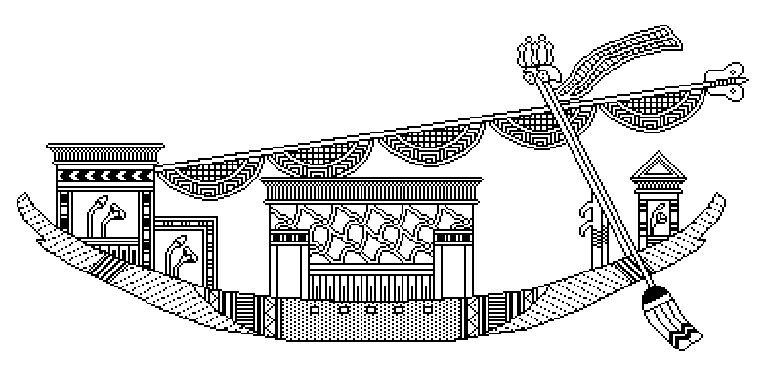
Among its other “strengths” in the eyes of some of its users may have been the fact that the Egyptian writing system was so mysterious and complicated that hieroglyphic literacy was able to remain largely a monopoly of professional priests and scribes! But something useful does not remain secret forever, and by late times a popularized “demotic” or “people’s” script was in wide use. But that’s another story.
1. In Chinese (nearly) every syllable is meaningful, even though a “word” can sometimes be a compound of several syllables:
huǒ (fire) + chē (vehicle) = huǒchē (locomotive).
2. In all dialects of Chinese throughout history, there have been limits on how complex a spoken syllable could be. For example in standard, modern Mandarin a syllable consists of: (initial consonant) + (vowel 1) + vowel 2 + (n or ng). (Items in parentheses are optional.) Further, each syllable is pronounced with one of four distinctive pitch patterns (tones), shown in Romanized spellings by distinctive accent marks: nián tǎn bǔ ā xiàn xiān are syllables in modern Mandarin. Pwat fas tril def skarp are not.
Standard modern Mandarin has 21 initial consonants, 37 “syllable finals” (vowels, diphthongs, or combinations of a vowel and final consonant), and 4 tones, to produce a theoretical total of 21 x 37 x 4 = 3108 possible syllables, although many theoretically possible syllables do not in fact occur.
3. Since there are so few syllable types, most spoken syllables have more than one field of meaning. For example:
biān = edge; whip; compile; bat; to pierce with a stone probe
fú = prop up; prisoner; fall; not; thus; bat; happiness; float
4. Chinese written characters represent syllables, but for each different “meaning” of a spoken syllable, there is a different written character (logograph):
biān = edge 邊; whip 鞭; compile 編; bat 蝙; or to pierce with a stone probe 砭.
fú = prop up 扶; prisoner 俘; fall 伏; not 弗; thus 夫; bat 蝠; happiness 福; or float 浮
5. Spoken language depends upon context to tell which “meaning” of a syllable is intended. Often, two-syllable “synonym compounds” help create this context and resolve the ambiguity:
biān-fú = bat (the only meaning shared by both biān and fú)

Note that in the written language either biān 蝙 or fú 蝠 can theoretically mean “bat,” so the compound 蝙蝠 corresponding to the spoken biānfú is technically redundant. In modern written Chinese this redundancy is tolerated. In Classical Chinese one written syllable alone was all that was normally considered necessary, and indeed excess redundancy was considered rather vulgar. Partly for this reason, in Classical Chinese, writing did not perfectly echo the spoken language, despite the capacity to do so, and well drafted Classical Chinese texts were quite abbreviated by the standards of modern usage.
6. Where do the logographs come from? Some Chinese characters directly represent concepts. (For example, the character for “big,” pronounced dà, represents a person with his arms spread: 大.) But most characters are compounds of (1) a meaningful “radical” and (2) a “phonetic” commonly associated with approximately the sound of the syllable. Thus in biān 蝙 and fú 蝠 (the two characters referring to bats) the 虫 part shared by both is a radical meaning “bug or small animal.” It works essentially the same way an ancient Egyptian determinative does. The 扁and 畐 are phonetics. Anything with a 扁 in in is likely to be pronounced biān or piān (or biăn or piăn); anything with a 畐 (or a 夫) in it is likely to be pronounced fū or fú.
There are conventionally considered to be 214 “radicals” and 888 “phonetics,” generating, in theory, 214 x 888 = 190,032 compound characters (plus the 214 radicals used in isolation and some composed in other ways). Today’s official “simplified” character set is slightly different, but the differences are minor. The largest Chinese dictionary lists 49,905 characters, leaving the hundred and forty thousand or so remaining permutations yet to be invented. It is said that the average person probably needs knowledge of something over 3,000 characters to be marginally literate. (In dynastic times some people apparently got on fine by learning only a handful of characters useful for their particular jobs, so “marginally literacy” turns out to be a more complicated idea than it appears to be.)
The Chinese Board of Standards approved a list of 6,763 for use in computerized word processing, but most writers feel that a computer type font with fewer than about 10,000 characters definitely cramps one’s style, so it is not clear that the 3,000 characters needed by one marginally literate person are the same 3,000 needed by another. Version 2 (1997) of the international Unicode standard, filled hexadecimal addresses 4E00 to 9FFF with a “Chinese-Japanese-Korean unified character set,” thus setting a standard for the near future of 20,991 characters for use in the world's computers. By Version 3 (published in 2000) an additional seven thousand were added. By Version 4 (2003) 70,207 characters were included, most still not actually available in most computer type fonts. And the number has continued to creep upward.
What These Examples Show. Both Egyptian and Chinese are popularly misunderstood. Both have a huge number of signs and both work differently from Western languages. Neither is alphabetic, despite the presence of an alphabet as one part of the Egyptian system. But both are nevertheless linked intimately to the sounds of the spoken language, and this is why both are able to function as full writing systems, in which it is possible to write grocery lists, love letters, or college exams.
Multiple-choice review questions are available for this reading arranged in three ways, depending upon the number of items blocked in a single quiz. A separate quiz covers the appendix.
Wimp Version (7 items per quiz)
Quiz 1,
Quiz 2,
Quiz 3.
Normal Version (10-11 items per quiz)
Quiz 1,
Quiz 2.
Hero Version (all items together)
Quiz.
Appendix Quiz (9 items)
Quiz.
Arabic Calligraphy (British Museum)
Costa Rica petroglyph (Museo Bancode, Costa Rica, photo by DKJ)
Hymn to Ninkasi (San Diego Museum of Man, exhibit poster, photo by DKJ)
Printed Hebrew (Internet Bible site)
Sequoyah (Cherokee Nation)
All other pictures by DKJ